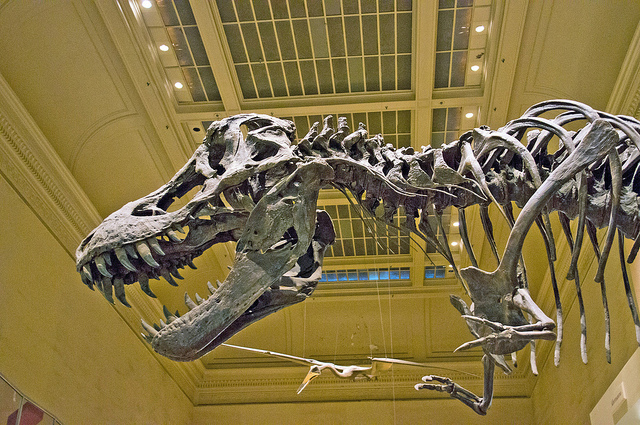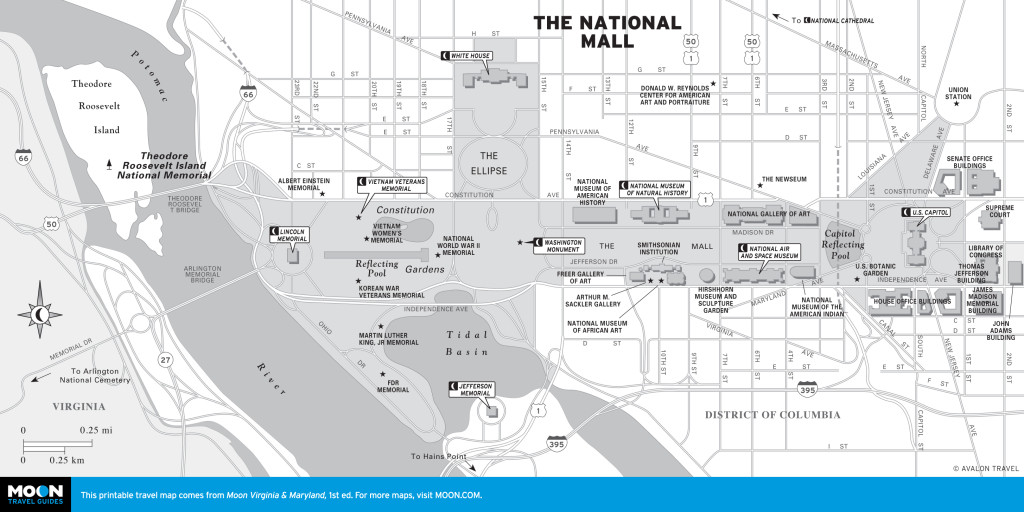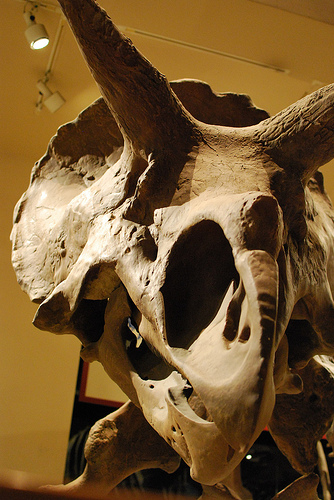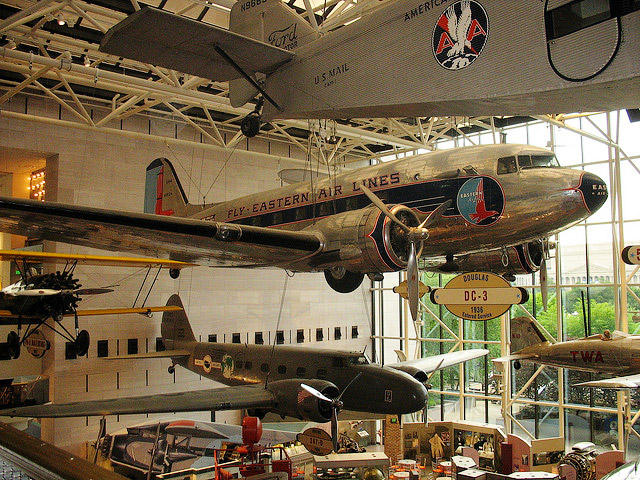
Oh, dang! Dinosaurs at the Smithsonian! Photo © United States Department of Agriculture, licensed Creative Commons Attribution.
Washington DC is known for its incredible museums. The most noted are those that are part of the Smithsonian Institution, the largest museum and research complex in the world. The Smithsonian Institution was founded in 1846 and is administered by the U.S. government. The majority of the Smithsonian museums, 19 in fact, are in DC, and many of them are architectural and historical landmarks.Oddly, the founding donor of the institution was British chemist and mineralogist James Smithson, FRS, M.A., who had never even been to the United States. An amateur in the fields of chemistry and mineralogy, Smithson inherited a large estate and in turn had no heirs to leave it to. His will stipulated that his estate would be donated to the founding of an educational institute in Washington DC.The Smithsonian Institution was established as a trust, and it functions as a body of the U.S. government, although separate from the legislative, executive, and judicial branches. Funding for the museums comes from contributions, the institution’s own endowment, memberships, government support, and retail and concession revenues. The Smithsonian employs approximately 6,300 people.
The majority of the Smithsonian museums, 19 in fact, are in DC, and many of them are architectural and historical landmarks. Nine research centers and the National Zoological Park are also part of the Smithsonian collection in Washington DC. Most of the Smithsonian facilities are open to the public daily except for December 25 with free admission.
The Smithsonian family also stretches to other parts of the country, including Virginia, Maryland, New York City, and Arizona. There are also many other museums that are affiliated with the organization.
First-timers to Washington DC will want to visit at least one of the major Smithsonian museums, but will most likely fill their dance card with several of the “biggies” on the National Mall (of which there are 11). Visitors should be aware that most of the museums on the National Mall do not offer dedicated parking facilities and require visitors to pass through security screenings upon entry.

The National Mall
Information on the Smithsonian can be found on the south side of the Mall at its headquarters, called the Smithsonian Castle (1000 Jefferson Dr. SW, 202/633-1000, daily 8:30am-5:30pm, free). This sandstone building, which opened in 1855, looks like something out of a fairy tale and houses an exhibit hall, administration offices, and Smithson’s remains (which were laid to rest in a crypt under the castle).
The National Museum of American History (1400 Constitution Ave. NW, 202/633-1000, daily 10am-5:30pm, free) is devoted to exhibits explaining the cultural, social, scientific, technological, military, and political development of the United States. The museum has three floors housing more than three million artifacts. Wings on each floor represent a different theme, each of which is represented by a large, significant, landmark object. Some examples include the 1865 Vassar Telescope in the west wing of the first floor, which is focused on science and innovation; a Civil War draft wheel in the east wing of the third floor, which is focused on political history; and a statue of George Washington in the west wing of the second floor, which focuses on American lives.
Some museum highlights include the Star-Spangled Banner, George Washington’s uniform, Thomas Jefferson’s lap desk, Archie Bunker’s chair from the TV series All in the Family, Dorothy’s ruby slippers from the Wizard of Oz, and the inaugural dresses worn by all the first ladies.
The one-hour guided tours offered are a good way to see the highlights quickly if you have a full docket of sights to get to on the same day. There is no public parking at the museum. Visitors riding Metrorail can use either the Smithsonian Mall stop or Federal Triangle.

You can learn important facts about dinosaurs at the Smithsonian, such as: triceratops was the best. Photo © Karen Neoh, licensed Creative Commons Attribution.
Another favorite Smithsonian creation is the National Museum of Natural History (10th Street and Constitution Avenue NW, 202/633- 1000, daily 10am-5:30pm, free). It first opened its doors in 1910 and is said to be the most visited natural history museum worldwide. The main building encloses 325,000 square feet of exhibit space and is overall the size of 18 football fields. The museum collections include more than 126 million specimens.
Visitors can expect to see plants, animals, fossils, rocks, meteorites, and cultural artifacts including a 13-foot-tall stuffed African elephant, the jaws of a giant prehistoric shark, and the Hope Diamond as well as a live butterfly pavilion ($6) and an IMAX theater ($6-15). The museum is also home to the largest group of scientists (approximately 185) that are studying the history of the world. Visitor concierges are available to answer questions throughout the museum and may be identified by their green vests. There is no public parking at the museum. Visitors riding Metrorail should exit at the Smithsonian station (Mall exit) on the Blue and Orange Lines.
The National Museum of the American Indian (4th Street and Independence Avenue SW, 202/633-6644, daily 10am-5:30pm, free) opened in 2004 and is the first national museum focused exclusively on Native Americans. The five-story, 250,000-square-foot limestone building sits on more than four acres of what is made to look like wetlands. The museum features approximately 825,000 items that represent more than 12,000 years of history and 1,200 indigenous American cultures. It also offers exhibits, film screenings, public programs, cultural presentations, and school programs.
An overwhelming favorite in the Smithsonian family of museums is the National Air and Space Museum (Independence Avenue at 6th Street SW, 202/633-2214, IMAX 866/868-7774, daily 10am-5:30pm, free, IMAX and planetarium entry extra). This incredible museum features the largest collection of air- and spacecraft in the world and is also a center for research on historic aviation, spaceflight, planetary science, geophysics, and terrestrial geology. The current exhibit space of 22 galleries and more than 160,000 square feet of floor space opened in 1976. Most of the hundreds of aircraft, spacecraft, rockets, missiles, and other aviation artifacts on display are originals.
Some highlights you can expect to see include the Spirit of St. Louis, the Apollo 11 Command Module, a DC-3 airplane, a production model of the USS Enterprise from Star Trek, and a real lunar rock.
Another great attraction located inside the National Air and Space Museum is the Albert Einstein Planetarium ($9). Several shows are offered daily and take visitors through the night sky with a first-of-its-kind Sky VisionTM dual digital projection system and digital surround sound.
Other favorite attractions in the museum include the Lockheed Martin IMAX Theater (IMAX shows $9, feature films $15) and flight simulators. One of the best museum shops is also here, and dining facilities are offered on-site.
Museum tours are offered daily at 10:30am and 1pm. There is no public parking at the museum, but several public pay lots are nearby. Metrorail riders should use the L’Enfant Plaza stop and exit at Maryland Avenue.

You can also see some non-dinosaur related stuff at the Smithsonian. Photo © Nikoretro, licensed Creative Commons Attribution.
Many people think the Hirshhorn Museum and Sculpture Garden (700 Independence Ave. SW, 202/633-4674, daily 10am-5:30pm, free) looks like a giant spaceship parked near the Mall. The design is an open concrete cylinder (231 feet in diameter) standing on four large supports. The idea behind this structure was for it to provide a sharp contrast to everything else around it. It succeeded. This modern art museum, which opened in the 1960s, is part of the Smithsonian Institution and houses one of the most noted collections of contemporary paintings and sculptures in the country focusing on the post-World War II era. A sculpture garden is located outside the museum.
The National Museum of African Art (950 Independence Ave. SW, 202/633-4600, daily 10am-5:30pm, free) is part of a quadrangle complex behind the Smithsonian Castle. The building is mostly underground and contains the largest public collection of African art in the nation with approximately 9,000 artifacts. Pieces include sculpture, jewelry, musical instruments, maps, films, and photographs.
The Freer Gallery of Art and the subterranean Arthur M. Sackler Gallery (1050 Independence Ave. SW, 202/633-1000, daily 10am-5:30pm, free) together form the national collections of Asian art. They contain the largest Asian art research library in the country (inside the Sackler Gallery) as well as art from all parts of Asia. Their collection of American art includes pieces by well-known artists such as Winslow Homer, Augustus Saint-Gaudens, and John Singer Sargent.
The Freer Gallery features Asian collections spanning 6,000 years that date back to the Neolithic era. Specific collections include stone sculptures from ancient Egypt, Chinese paintings, Persian manuscripts, and Korean pottery. The Freer’s most famous exhibit is the Peacock Room painted by American artist James McNeill Whistler, which is a room restored to how it appeared in 1908 when the founder of the museum, Charles Lan Freer, used it to display over 250 ceramic art pieces he had collected from Asia. Freer was a railroad car manufacturer in Detroit who was a self-taught connoisseur.
The Sackler Gallery contains a founding collection of approximately 1,000 items that were donated by American psychiatrist, entrepreneur, and philanthropist Arthur M. Sackler.
The collection has both ancient and contemporary items including South and Southeast Asian sculpture, Chinese jade, and Middle Eastern ceramics. The museums are on the south side of the Mall.
It may come as a surprise that the Smithsonian operates the Mall Carousel (12th Street and Jefferson Drive SW, 202/633-1000, daily 10am-5:30pm, $3.50). This favorite children’s thrill ride with the blue and yellow awning is in front of the Smithsonian Castle. It offers three minutes of fun on faded painted ponies that were built in the 1940s. The carousel was originally at the Gwynn Oak Amusement Park in Maryland prior to coming to the Mall.
The National Gallery of Art (4th Street and Constitution Avenue NW, 202/737-4215, Mon.-Sat. 10am-5pm, Sun. 11am-6pm, free) first opened in 1937 when Andrew W. Mellon donated funding and a large art collection from multiple collectors for the enjoyment of the people of the United States. The gallery traces the development of Western art from the Middle Ages to current times through paintings, prints, drawings, sculpture, photographs, and other media. The only portrait in the Western Hemisphere painted by Leonardo da Vinci is housed in this museum. The gallery is a campus that includes the original museum building (the West Building), which features sculpture galleries with over 900 works or art; the newer East Building, which contains a collection of modern paintings, drawings, prints, offices, and research centers; and a 6.1-acre outdoor sculpture garden (open year-round).
Excerpted from the First Edition of Moon Virginia & Maryland.